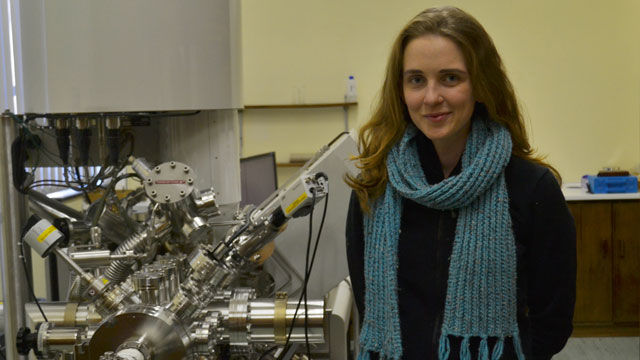
By Anima McBrown
Miss Jessica Anne Harris, a MSc Chemistry student supervised by Professor Nyokong, is the proud 2016 South African Women in Science Awards (WISA) winner.
The presence of RU’s top scientists at the forefront of South African science and technology is no new phenomenon. Harris follows in the steps of a fellow Masters student, Miss Siphesihle Robin Nxele – who received the WISA accolade last year.
Rhodes has also been a home for Miss Xolisile Thusini (who did her Honours at Rhodes), another 2016 WISA winner who is now completing her Master’s degree in the Department of Physics at UCT.
Having completed a BSc in 2013 (Chemistry and Physics) and a BScH in 2014 (Chemistry, with distinction) at RU, Harris visited China’s Nanjing University in December 2015 for an exciting three-week research trip supervised by Prof Zhen Shen. She worked on the synthesis of fused-ring-expanded subphthalocyanines. In June 2016 she travelled to the United Kingdom for a month-long research visit to University College London (UCL) – with Prof Sandy Macrobert.
Harris’s research topic focuses on developing dyes for photodynamic therapy (PDT), a non-invasive alternative cancer therapy. Mail & Guardian’s special WISA advertorial details her project as:
“the development of dyes for photodynamic therapy (PDT) treatment of cancer”. While radiation and chemotherapy result in the damage of both healthy and diseased cells, PDT is able to destroy cancerous cells more selectively. The Mail & Guardian goes on to explain the principle of PDT: “Dye is injected into the bloodstream, and is then activated by shining a laser light at the tumour site. The excited dye transfers energy to oxygen present in the tissue, producing highly reactive singlet oxygen, which results in cell death.”
Harris explains that PDT is more selective in that it requires the presence of 3 factors:
(i) A suitable photosensitiser (dye), which is activated by light,
(ii) A light source (in this case a laser) and
(iii) Oxygen present in the tissues.
In the absence of any one of these factors, no cell damage will occur. Hence, as laser light is only shone at the affected area, damage to healthy cells is significantly limited. All of this makes safer, localised cancer treatment possible.
Harris has developed a couple of dyes already, and is now working on testing them in the RU labs. Her wrap-up towards the end of this year will include an intensive cell study to look at the toxicity and PDT effect of her dyes.
bbin宝盈集团 her WISA nomination she comments: “I didn’t realise how big WISA is, but I was extremely happy to be nominated”. Having attended the gala event in Johannesburg with her proud mother as the perfect plus one, she was glad to see that Women in Science is a national and international concern that is garnering all-round support from government and corporate business. “It is unbelievable to see women doing it all; they have full lives and still dedicate sufficient time to carrying out fundamental research in science and technology”, says Harris.
She has been greatly inspired and wants to see the Department of Science and Technology (DST) grow and support more women leaders in the field. She believes that there is a “need for role models” who can act as living, working and pioneering examples to young scientists and researchers. “To actually be able to see ourselves at the next step of our research careers, we need to be looking at and learning from women who are already at that next step. Having strong role models shows us that it is a reality: that we can do it all – without neglecting all our other values and interests”, comments Harris.
She agrees with Minister of Science and Technology Naledi Pandor that part of the way to grow science, and dispel the stigma of its study as exclusive and far removed, is to make science and technology dinner table conversation. “We need to be able to communicate science to every kind of person, regardless of their background”, says Harris.
Harris’ take home message is this: science does not need to happen in a vacuum. When enough people come together, pulling the right resources and putting their best foot forward, truly amazing things happen. Her work is evidence of this. We wish Jessica every success in this pioneering research.
Photo credit/s: Ntsika Kota

